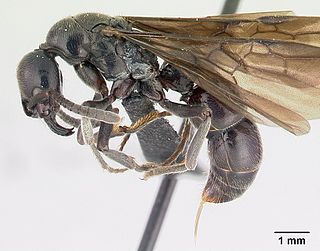
Ponerinae is a subfamily of ants in the Poneromorph subfamilies group, with about 1,600 species in 47 extant genera, including Dinoponera gigantea - one of the world's largest species of ant. Mated workers have replaced the queen as the functional egg-layers in several species of ponerine ants. In such queenless species, the reproductive status of workers can only be determined through ovarian dissections.

Harpegnathos is a small ponerine genus of ants found in South and Southeast Asia. They are notable for their jumping ability, complex colony structure, and large to very large workers easily identifiable by their long mandibles and large eyes.

Pachycondyla is a ponerine genus of ants found in the Neotropics.

Ponera is a genus of ponerine ants. The name is the Latinized form of the Ancient Greek ponira.

Centromyrmex is a pantropical, though mainly Afrotropical, genus of ants in the subfamily Ponerinae. This ponerine ant was recorded for the first time in French Guiana and the most northerly point of recording was in Costa Rica. The specimens reported here were collected in a region of Amazon Forest with flight interception traps.

Boloponera is a genus of small ants in the subfamily Ponerinae. The genus contains the single species Boloponera vicans, known from a single worker specimen collected in leaf litter in the Central African Republic. It is sometimes referred to as Bry's Ant after its discoverer, Brian Fisher.

Dolioponera is a genus of small ants in the subfamily Ponerinae containing the single species Dolioponera fustigera. The genus is known only from a few specimens from west and central Africa. Little is known about their biology, and males remain unknown.

Emeryopone is a small genus of ants in the subfamily Ponerinae. The genus is distributed in Asia, from Israel to Indonesia. Little is known about their biology, and males remain unknown.

Buniapone is a monotypic genus of ants in the subfamily Ponerinae. Buniapone amblyops, the single described species, is found in Southern and Southeast Asia.

Iroponera is a monotypic genus of ants in the subfamily Ponerinae. Iroponera odax, the single described species, is known only from a few collections in Australia.

Parvaponera is a genus of ants in the subfamily Ponerinae. The genus is distributed in Africa, Southeast Asia, Australia and the Solomon Islands. Workers are slender and small in size. Queens are similar to workers, but larger and winged.

Rasopone is genus of ants in the subfamily Ponerinae. The genus is restricted to Central and South America.

Ectomomyrmex is a ponerine genus of ants found in Asia and Australia. Little is known about their biology, but they seem to be generalist predators of arthropod prey.

Euponera is a ponerine genus of ants distributed in the Afrotropics and eastern Asia. Workers are large (6–10.5 mm); queen are similar to workers, but larger and winged.

Fisheropone is a genus of ants in the subfamily Ponerinae. Known from central Africa, it contains a single described species Fisheropone ambigua, and at least one undescribed species. Nothing is known about its biology.

Hagensia is a small genus of ants in the subfamily Ponerinae. Its two species are known only from coastal areas in South Africa. Workers are large (10.5–13.0 mm); queens are unknown, but gamergates occurs in both species.

Mayaponera is a genus of ants in the subfamily Ponerinae. It contains the single species Mayaponera constricta, found in Central and South America. Workers are slender and medium in size (6–7.5 mm).

Mesoponera is an Old World genus of ants in the subfamily Ponerinae. It is found in the tropics, from Sub-Saharan Africa to Australia.
Ophthalmopone is a ponerine genus of ants found in Sub-Saharan Africa. Workers are slender and large in size (8–13.5 mm). Queens seem to be absent, but gamergates present.

Pseudoneoponera is a ponerine genus of ants found from India to Australia, they are mostly non queen species, most of the species within the genus thrives on only gamergates.



















